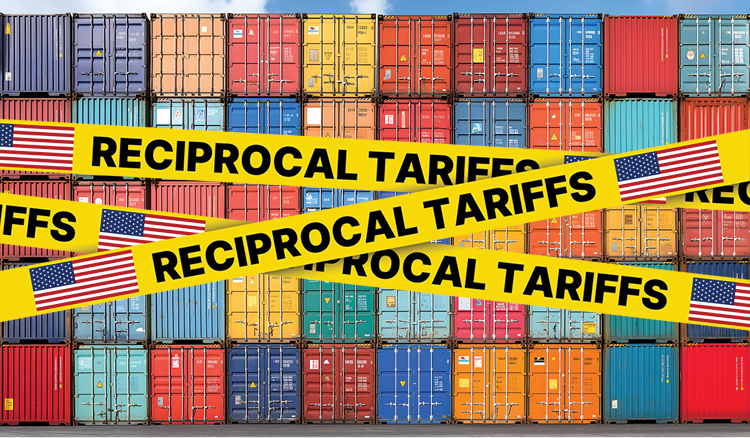Breaking Down Trump’s New Reciprocal Tariffs, The De Minimis Loophole Closure, and The New Tariff On Beer Imports
On Wednesday April 2nd, President Trump’s long-awaited reciprocal tariff plan was finally unveiled at a Press Conference at the White House’s Rose Garden.
In this article, we’ll discuss the details and implications of these new reciprocal tariffs, as well as the de minimis loophole closure and new imported beer tariff. We also offer strategic advice for manufacturers and distributors on how to quickly pivot and capitalize on the opportunities that will present themselves in the coming months.
If you’re looking for information on the new 25% vehicle tariff that already took effect on April 3rd, check out this article.
Reciprocal Tariff Breakdown
Starting on Saturday April 5th at 12:01AM, a blanket 10% tariff will apply to all countries.
Countries with whom the U.S. has larger trade deficits with on the other hand will be subject to higher tariffs, which range anywhere from 11-50% and are listed in the chart below. In most cases, these new reciprocal tariff rates are roughly half of what the Trump administration claims each of these countries has been charging.
These country-specific tariffs will go into effect on Wednesday, April 9th at 12:01AM.

If you find this chart hard to read, you can find it online by clicking here.
Noticeably absent from this list are Canada and Mexico, who did not receive any reciprocal tariffs, but are still subject to the:
- 25% tariff on non-USMCA qualifying goods
- 25% tariff on steel & aluminum
- 25% vehicle tariff
- 10% tariff on Canadian energy resources
While Mexico may have been spared from the reciprocal tariffs, on Wednesday the U.S. Department of Commerce announced an expansion of the Section 232 tariffs to include 2 aluminum derivative products: beer and empty aluminum cans starting on Friday April 4th. With more than 80% of U.S. beer imports in 2024 coming from Mexico, this will be a major blow to Mexico. This of course will provide a massive opportunity for domestic producers of both beer and aluminum cans.
Also important to understand, is that in some cases, these reciprocal tariffs stack on top of other existing tariffs. China for example, who was already subject to a 20% tariff, will now be subject to a total tariff of 54%.
Imports already subject to other tariffs however will be spared for now.
These include:
- Vehicles & components
- Steel & Aluminum
- Lumber
- Pharmaceuticals
- Copper
- Bullion
- Energy resources and minerals not produced domestically
While only vehicles, and steel & aluminum products are currently subject to other tariffs, the Trump administration has outlined plans for new sectoral tariffs for the remainder of these imports. While the timing of these is still up in the air, reports indicate that these tariffs will likely start at 25%. Trump has also stated that he’d like to increase these over time, but wants to at least give companies a chance to reshore.
Immediate Retaliation from Trade Partners
China announced Friday morning that they will impose a new 34% tariff of their own in retaliation. But that’s not all. In addition to the tariff itself, China also added 11 U.S. companies to its unreliable entity list*, and put export controls on 16 companies to prohibit the export of Chinese dual-use items**.
*Unreliable entity list: companies on this list are prohibited from engaging in import and export activities with China, and are prohibited from making new investments within China
**Dual-Use Items: goods, technologies, and services that may be used either to fulfill civil or military purposes or to contribute to an increase in military potential.
China also unveiled export controls on 7 rare earth minerals to the U.S., including samarium, gadolinium, terbium, dysprosium, lutetium, scandium, and yttrium. Lastly, China announced that they will be filing a lawsuit with the World Trade Organization over these tariffs.
While no other counties have announced sweeping retaliatory measures so far, this will likely change as we near the April 9th implementation date. It’s likely that Mexico, who was spared by the reciprocal tariffs but will be hit hard by the new tariff on beer, will retaliate in the next week.
The U.K. hasn’t ruled out retaliation either, even though they were only hit by a 10% tariff.
Also, while White House officials have insisted that these reciprocal tariffs are non-negotiable, Trump rebuked this claim in an interview on Thursday aboard Air Force One and stated he is open to negotiations. Already, Vietnam, who was hit with a higher tariff of 46% has claimed they are willing to drop their 90% tariff on U.S. imports if they can work out an agreement.
With the implementation date now less than 5 days away, expect new developments on this front.
De Minimis Loophole Closure
While much of the media attention this week has been focused on the reciprocal tariffs, the upcoming closure of the de minimis loophole is certainly not something to overlook.
This loophole currently allows shipments worth less than $800 to enter the U.S. duty-free, and has been exploited in recent years as shoppers have gravitated to Chinese companies selling cheap goods like Shein and Temu.
While much of the criticism of this rule has been due to the fact that it creates an unfair advantage for Chinese companies, the Trump administration’s decision to close it is mainly due to concerns that since the packages are less likely to be inspected by customs agents, the loophole encourages shipments of fentanyl and other illegal drugs.
The Trump administration first ended this loophole in February, however due to the fact that it completely overwhelmed the U.S. Customs and Border Protection employees and forced the postal services to temporarily halt packages from China and Hong Kong, Trump reversed course and delayed the closure.
Now on April 2nd, Trump signed an executive order ending de minimis treatment for goods from China and Hong Kong starting on May 2nd at 12:01 a.m. EDT. Specifically, goods that previously qualified under the de minimus exemption will be subject to a duty of either 30% of their value, or $25 per item. Additionally, the rate will increase to $50 per item on June 1st. This will also stack on top of existing tariffs.
Emerging Opportunities
With negotiations currently underway, retaliatory actions expected, and changes to these tariffs likely as we approach the implementation date, it’s difficult to predict the exact impact of these tariffs. But regardless of how things play out in the next few days, this will be a major win for U.S. manufacturers and distributors in the long run as it will essentially force companies to reshore production. Once these take effect next week, we’ll release another article diving deeper into the exact implications.
Despite this uncertainty, a few things are certain. And that’s that domestic beer producers truly have the opportunity of a lifetime in front of them, especially as we approach peak season for beer consumption. For context, the U.S. imported more than $7 billion worth of beer in 2023, which amounts to more than 21% of beer consumed in America.
Will some consumers be willing to pay more for beer imported from Mexico? Probably. Will the vast majority of consumers be willing to pay more? No.
This presents tremendous growth opportunities for domestic producers who can quickly pivot and rise to the occasion.
For the hundreds of beer producers and distributors, as well as aluminum can manufacturers with a flexible workforce in place, scaling up to capitalize on this opportunity will be a breeze.
Those who don’t have the ability to drastically increase labor capacity in just 1-2 days and are stuck in the old way of doing things are in for a rude awakening.
Direct hiring is a several week long effort and is simply too slow, and while staffing agencies may be able to get you help slightly faster, these so-called “solutions” come with added risks, restrictive contracts, and a lack of flexibility.
Now imagine a better way: an approach that enables you to take action on upcoming labor needs within hours—not weeks. With Veryable, this is possible.
Veryable's on-demand labor model eliminates the inefficiencies of the direct hiring process and the headaches of dealing with staffing agencies, providing access to 700k+ skilled and vetted workers at the click of a button. No waiting and no red tape. It’s a solution truly built for this moment in time.
To learn more about why this approach is superior to traditional methods in today’s uncertain environment, check out this article or visit our info for your role page.
Conclusion
While it’s likely that there will be changes to these tariffs in the next few days as U.S. trade partners look to negotiate, these new tariffs will undoubtedly be the catalyst needed to fuel the U.S. manufacturing renaissance. With our mission being to revitalize the U.S. manufacturing sector, we couldn't be more excited for what's to come.
If you haven’t already, make sure to check out our recently launched U.S. Manufacturing Today Podcast. Hosted by our Head of Reindustrialization Matt Horine, this podcast dives deep into these changes and their implications for manufacturers and distributors. Episode 4, which will be released on Tuesday April 8th, will cover “Liberation Day’ and some of the new developments we’ve discussed in this article.
Additionally, on our Navigating Trump 2.0 page, is a full breakdown of the changes that have taken place so far as well as an outline of potentially what’s to come. Also on this page, you’ll see an assortment of blog articles like this one, as well as others that provide a more in-depth analysis of the benefits of a Veryable workforce strategy at this moment in time.
Previous Posts
What Kind of Skilled Work Can Veryable Operators Do?
The Future of Manufacturing and Logistics
Create a free business profile today to explore our platform.






